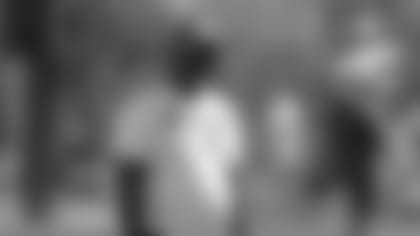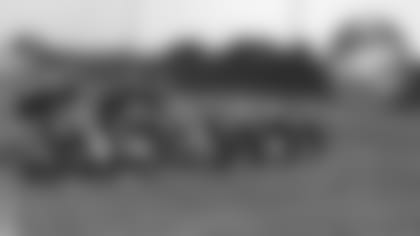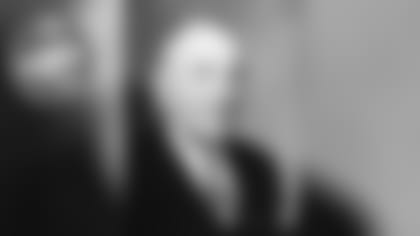For Part I of the misidentified pictures, click here.
More photos. More mistakes.
The above photo of Packers officials, Gerald Clifford, Curly Lambeau, Andrew Turnbull, Fred Leicht, Lee Joannes, Emil Fischer, Frank Jonet and Tubby Bero, was ID'd in one book as a photo of a meeting taken in the Attic Room of the Beaumont Hotel in early November 1922. The caption incorrectly added it was taken after a game against Columbus and was where the decision was reached to hold a public stock drive.
Sadly, this mistake cuts to core of the Packers' existence. The people might be properly identified, but there is nothing else right about that caption. All it does is muddle the story of what the Packers are all about, a team owned by its fans.
Here's the first red flag. Lambeau was 24 years old in 1922; Bero, 26; Leicht, 27; and nobody else pictured had reached the age of 40. Does this look like a gathering of 20- and 30-year olds?
The second red flag: The seven men pictured, other than Lambeau, actually comprised the executive committee when The Green Bay Packers, Inc., was established in 1935. Clifford, Leicht, Fischer and Bero weren't actively involved with the Green Bay Football Corporation, formed in 1923, nor were any of them even members of its board of directors until 1929.
The third red flag: While the Packers lost money on the Columbus game due to a heavy rain, it was the Thanksgiving Day booster game against Duluth in 1922, also played in a deluge, that was almost cancelled and led to the first stock drive.
George Whitney Calhoun, Green Bay Press-Gazette sportswriter and one of the owners of the team that year, referenced it in the second paragraph of his game story on Dec. 1, 1922. "At one time it was thought the game would be called off but in order to keep with the fans, the management went through with the contest despite a big monetary loss," he wrote.
Because of what The Duluth Herald described as a "twelve-hour rain," Lambeau, Calhoun and perhaps the other owners of the private Green Bay Football Club huddled before the game and were ready to call it. But Turnbull, one of the owners of the Press-Gazette, told them if they did, pro football would be dead in Green Bay. Instead, he convinced the others to play and promised he would rally community leaders behind the team before the 1923 season.
A week later, Turnbull and attorney John Kittell called the first meeting of local businessmen that led to the creation of the non-profit, publicly owned Green Bay Football Corporation.
"Proposals covering the transfer of the franchise to a holding organization of businessmen will be put before the meeting," the Press-Gazette stated in its Dec. 7, 1922 edition. It added, "Immediate action is necessary and the businessmen have called tonight's conference in an attempt to lay a firm foundation for next season."
Calhoun wrote several times over the course of his newspaper career that the Duluth game "marked a turning point in the history of the Packers." In addition, Turnbull said in more than one interview during his lifetime, including one with Oliver Kuechle of The Milwaukee Journal in 1939, that it was the Duluth game that triggered the Packers becoming community-owned.
When the above picture ran in the Press-Gazette on June 22, 1988, the caption with credit line stated it was taken in the 1930s and furnished by Daniel Beisel, who was Turnbull's son-in-law, a member of the Packers' board of directors and former publisher of the Press-Gazette.
While the Packers became a community-owned team in 1923, the present corporation wasn't created until 1935.
To write that Clifford signed and likely drafted the Articles of Incorporation for The Green Bay Packers, Inc., is correct. But he didn't do so until 12 years after Kittell signed and almost certainly drafted the original articles for the similarly structured Green Bay Football Corporation.
The Green Bay Football Corporation went into receivership in 1933 as the result of a fan's lawsuit and folded, and that led to the creation of Green Bay Packers, Inc. Turnbull, Joannes and a few others were involved in the formation of both corporations. But Kittell died in 1932.

Captions in several books have stated the fans in the above photo were watching the Packers play in 1919, their first season.
Not possible.
There's a fence in the background and the Packers played their first season in an open area in Hagemeister Park with no fence or bleachers. The only way they could raise money was for Calhoun, the team's co-founder, and others to pass a hat among the crowd and hope people would drop in their spare change.
Also, in 1981, photographer Hank Lefebvre, who worked for The Stiller Company from 1921 to 1936, said Ernie Stiller shot the first photos at a Packers game with a 3A Kodak in 1920. For the record, the 1919 Packers team pictures were taken after the season ended in front of the old Indian Packing Co. garage.
In 1957, the picture above appeared in the Press-Gazette and the caption said it was from a game around 1920. That's more than plausible because a fence was erected around the Hagemeister Park playing field that year.
In 1954, a similar picture ran in the Press-Gazette and the caption said it was of a standing-room crowd at Bellevue Park in 1924, but it provided a "good idea of how Hagemeister Park looked" the day of the Packers' first game, Sept. 14, 1919. While that caption hedged on the specifics, it was believable except for the fence in the background. Even after the first bleachers were built in 1920, there were standing-room areas at both Hagemeister and Bellevue Park through 1924.

The above photo has appeared in more than one book and been wrongly identified as an early Packers action shot. In fact, it was put up for auction, billed as the earliest action photo of the Packers and Lambeau, and sold online for more than $4,600.
The photo was taken on Dec. 8, 1917, appeared in the 1918 Green Bay West High School Yearbook and was from a high school football game played between Marinette and Watertown and promoted by the Press-Gazette as a battle for the state championship.
While the game was played in a ballpark in Hagemeister Park, it wasn't one the Packers ever used. The ballpark in the above picture was torn down in the spring of 1918, four years after Green Bay lost its minor-league baseball team, which had been the primary tenant.
In fact, there were at least four different ballparks in at least two different locations in Hagemeister Park's relatively brief 25-year history; and the Packers played in three different settings, although not necessarily locations, in the four years they played there.
The Packers' story is the greatest in sports.
What other team started out playing on a vacant lot and passed a hat to raise money, needed volunteers to go door-to-door to sell tickets, and had fans who were willing to pay admission to listen to results off a Western Union wire and show up by the thousands to welcome home their heroes following a loss?
The answer is none and the sad fact is those who have been peddling fiction, as pointed out in the captions to several photos over the past two weeks, can't dream up stories better than the real thing.















